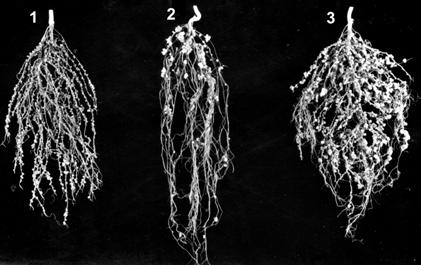
Sidorova,
K.K., Shumny, V.K.,
Inst. of Cytol. and Genet.
Vlasova, E.Yu, Glianenko, M.N.,
Russian Acad. of Sci.,
Gayeva, T.A. and Mischenko, T.M.
K301 (nod4), a supernodulating mutant, and cultivar Torsdag (Nod5) were crossed to study the interaction of two symbiotic genes, nod4 and Nod5, in a single genotype (1, 2). Both lines form nitrate-resistant symbioses. However, K301 produces a large number of small nodules all over the root, whereas Torsdag produces large nodules that are largely confined to the upper part of the root (Fig. 1). K301 was induced from cultivar Ramonsky 77 (nod5), which, unlike Torsdag, produces, when grown on a nitrogen medium, either a very small number of normal nodules or initial inactive nodules.
The plants were grown in the hydroponics greenhouse on a ceramsite as a substrate. Growing conditions were according to the guidelines for the use of such greenhouses (3). The plants were grown with nitrogen added to the standard mineral mixture as nitrate salts. The greenhouse temperatures were 20-22░C during the day and 14-15░ in the night. The light/dark ratio in hours was 16/8. The seedlings were inoculated by Rhizobium leguminosarum strain 250a. Nitrogenase activity was determined by the acetylene reduction method. Nodule number and nitrogenase activity were determined at flowering. The roots were also photographed at flowering. Unlike the recessive supernodulation genes, the dominant Nod5 gene does not reduce productivity (4).

![]()
Individual plants expressing a supernodulation phenotype were identified in the F2, after which lines were developed and studied up to F7.The symbiotic properties and productivity indices of inbred lines were assessed in the F7 (Fig.2). Of particular interests was the observation that all the recombinant inbred lines showed a much higher number of nodules than either K301 or Torsdag. Even when combined, the indices of symbiotic properties of both parents were considerably lower than those of the recombinant inbred lines. In most lines, nitrogenase activity was higher than that in the parental forms (Fig. 2).
Such productivity indices as height, seed number and seed weight per plant were higher in the recombinant inbred lines than in the supernodulating mutant K301. Apparently, the expression of the mutant gene changed after it was transferred to a different genotypic environment, and the negative effect of supernodulation on productivity indices was reduced.
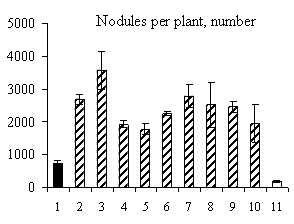
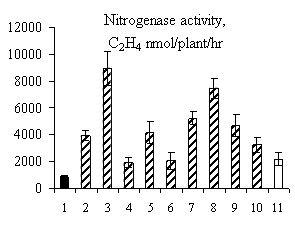
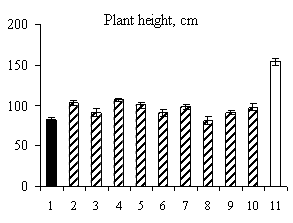
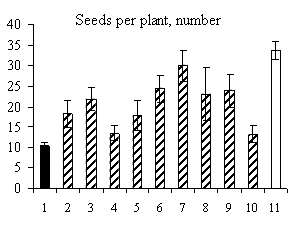
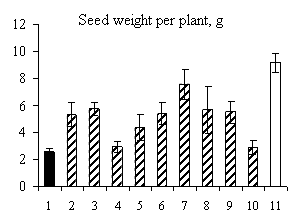
Fig. 2. Symbiotic characteristics and fertility of recombinant inbred supernodulating lines developed by crossing supernodulating mutant K301 (nod4) with Torsdag (Nod5). 1 ¢ mutant K301 (nod4); 2-10 ¢ recombinant inbred lines developed from the K301 х Torsdag (nod4, Nod5); 11 - cultivar Torsdag (Nod5)
1. Sidorova, K.K. and Uzhintseva, L.P. 1995. Pisum Genetics 27: 21.
2. Sidorova, K.K., Shumny, V.K., and Mischenko, T.M. 1999. Proc. Acad. Sci.: 367: 851-852 (in Russ.).
3. Chesnokov, V.A. and Bazyrina, Ye.N. 1957. Vestnik selskokhoziaystvennoy nauki 4: 121-128 (in Russ.).
4. Sidorova, K.K. and Shumny, V.K. 2003. Genetika 39: 501-509 (in Russian).